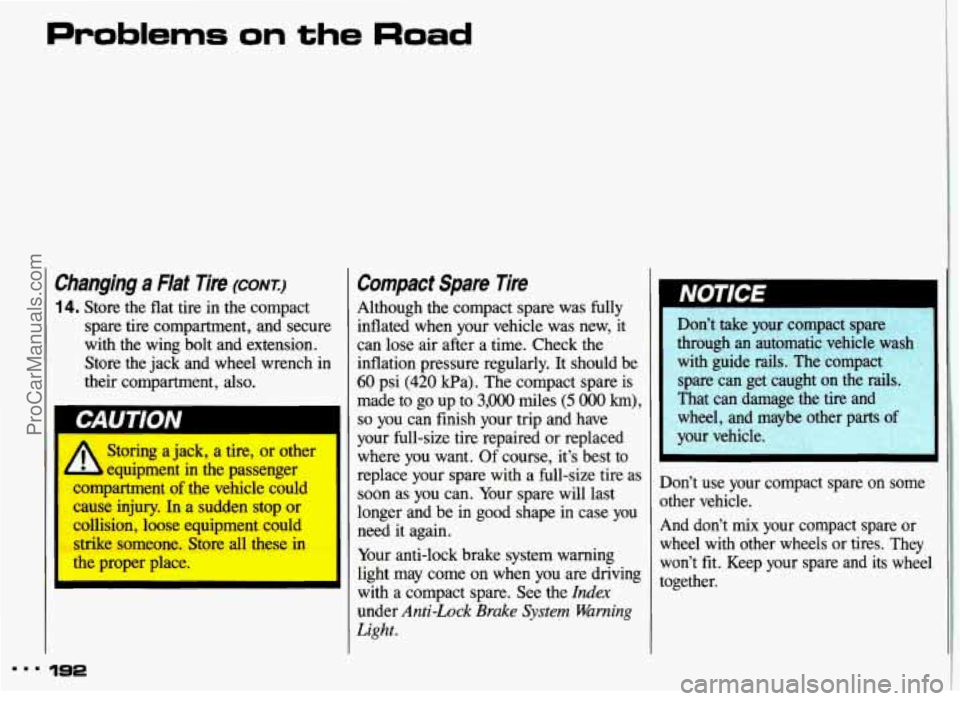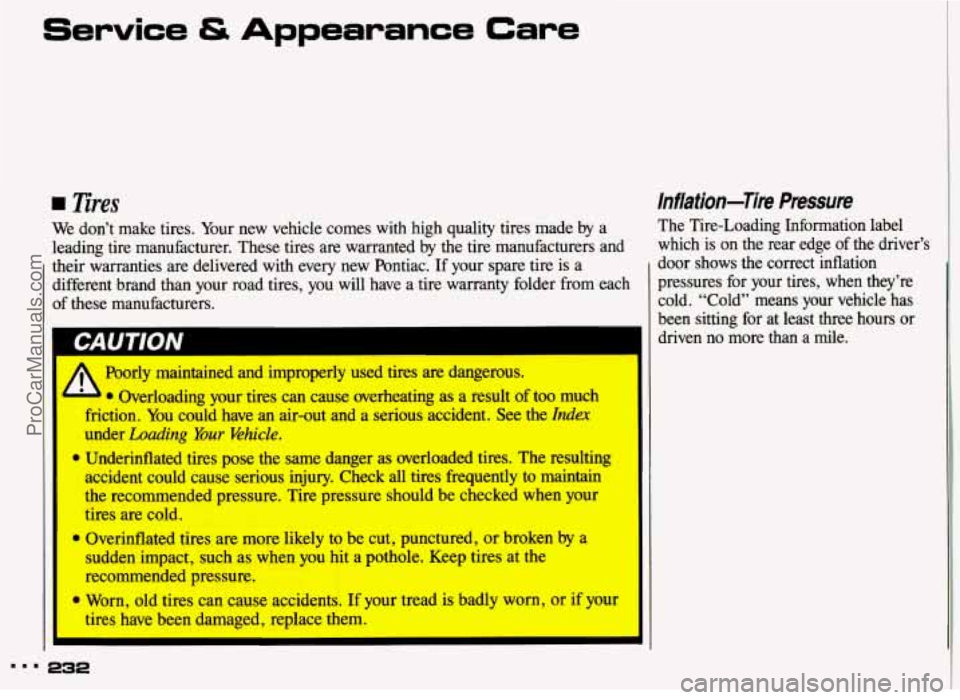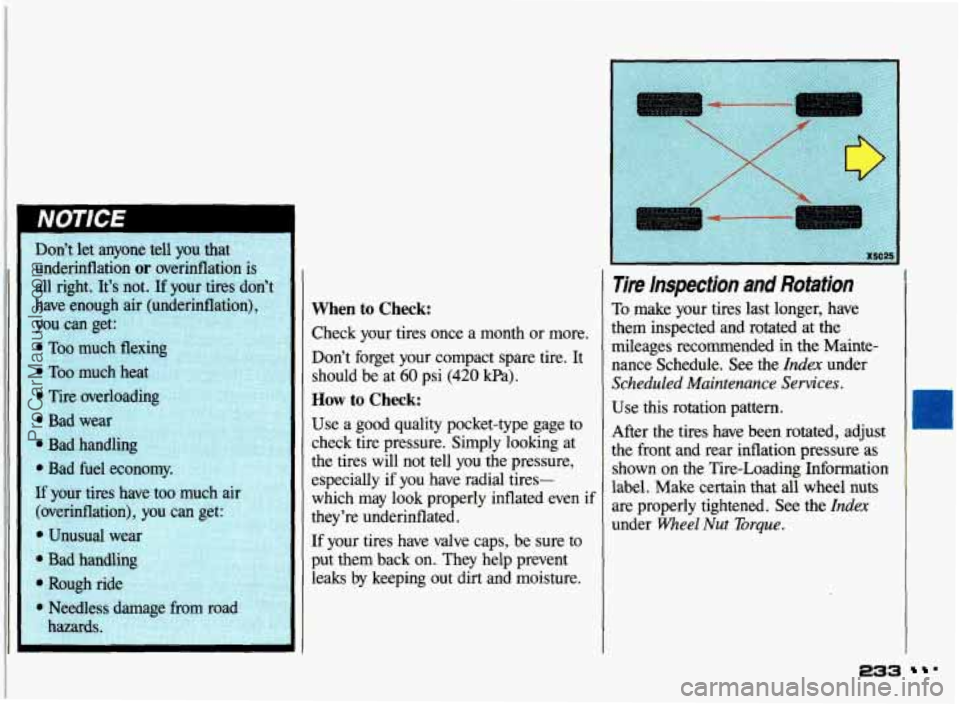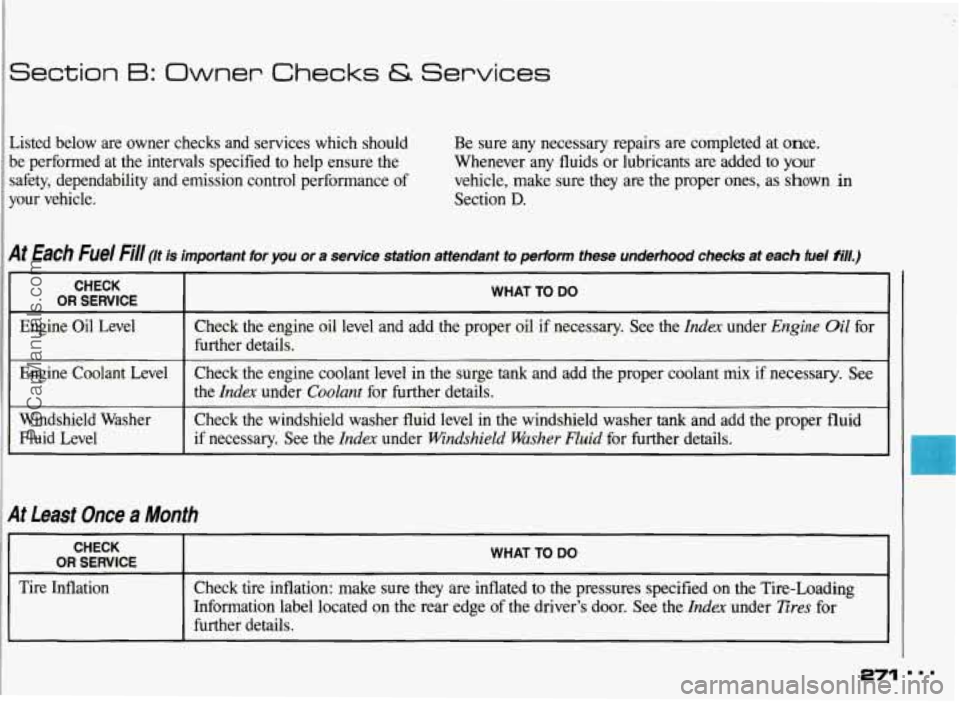1993 PONTIAC GRAND-AM inflation pressure
[x] Cancel search: inflation pressurePage 193 of 306

Changing a Flat Tire (corvr)
14. Store the flat tire in the compact
spare
tire compartment, and secure
with the
wing bolt and extension.
Store the jack and wheel wrench in
their compartment, also.
I A Storing a jack, a tire, or other
- equipment in the passenger
ompartment
of the vehicle could I
cause injury. In a sudden stop or
collision, loose equipment could strike someone. Store all these in
the proper place.
i
Compact Spare Tire
Although the compact spare was fully
inflated when your vehicle was new, it can lose air after a time. Check the
inflation pressure regularly. It should be
60 psi (420 Wa). The compact spare is
made to go up to
3,000 miles (5 O00 km),
so you can finish your trip and have
your full-size tire repaired or replaced
where you want.
Of course, it’s best to
replace your spare with a full-size tire as
soon
as you can. Your spare will last
longer and be in good shape
in case you
need it again.
Your anti-lock brake system warning
light may come on when you are driving
with a compact spare. See the
Idex
under Anti-Lock Brake System Warning
Light.
192
Don’t take your compact spare
through
an automatic vehicle wash I
with guide rails. The compact spare can get caught on the rails.
That can damage the tire and
wheel, and maybe other parts
of
your vehicle.
)on? use your compact spare on some
)ther vehicle.
ind don’t
mix your compact spare or
vheel with other wheels or tires. They
von’t
fit. Keep your spare and its wheel
ogether.
ProCarManuals.com
Page 231 of 306

Service & Appearance Care
Windshield Wiper Blade
Replacement
Replacement blades come in different
types and are removed in different ways.
Here’s how to remove the type with a
release clip:
1 . Pull the windshield wiper arm away
2. Lift the release clip with a
from the windshield.
screwdriver and pull the blade
assembly off the wiper arm.
the wiper arm.
3. Push the new wiper blade securely on
Loading bur Vehicle
Two labels on your vehicle show how
much weight it may properly carry. The
Tire-Loading Information label found on
the rear edge of the driver’s door tells
you the proper size, speed rating and recommended inflation pressures for the
tires on your vehicle. It also gives
you
important information about the number
of people that can be in your vehicle and
the total weight that you can carry. This
weight is called the Vehicle Capacity
Weight and includes the weight of all
occupants, cargo, and all nonfactory- installed options. The other label is the Certification
sticker, also on the rear edge of the
driver’s door. It
tells you the gross
weight capacity of your vehicle, called
the GVWR (Gross Vehicle Weight
Rating). The GVWR includes the
weight of the vehicle, all occupants, fuel
and cargo. Never exceed the GVWR for
your vehicle, or the Gross Axle Weight Rating (GAWR) for either the front or
rear axle.
And, if you do have a heavy load, you
should spread it out. Don’t carry more
than
132 lbs. (60 kg) in your trunk.
ProCarManuals.com
Page 233 of 306

Service & Appearance Care
nres
We don’t make tires. Your new vehicle comes with high quality tires made by a
leading tire manufacturer. These tires are warranted by the tire manufacturers and
their warranties are delivered with every new Fbntiac. If your spare tire is a
different brand than your road tires, you will have a tire warranty folder from each
of these manufacturers.
Poorly maintained and improperly used tires dangerous.
a Overloading your tires can causy overheating as a result of too much
friction. You could have
an air-out and a serious accident. See the Index
under Loading Your Ehicle.
Underinflated tires pose the same danger as overloaded tires. The resulting
accident could
cause serious injury. Check all tires fiquently to maintain
the recommended presswe. Tire pressure should be checked when your
tires are cold.
Overinflated tires are more likely to be cut, punctured, or broken by a
sudden impacts such as when you hit a pothole. Keep tires at the
recommended pressure.
tires have been damaged, replace them.
m Worn, old tires can cause accidents. If your tread is badly worn, or if your
I I
lnflation-Tire Pressure
The Tire-Loading Information label
which is on the rear edge of the driver’t.
door shows the correct inflation
pressures for your tires, when they’re cold. “Cold” means your vehicle has
been sitting for at least three hours or
driven no more than a mile.
ProCarManuals.com
Page 234 of 306

When to Check:
Check your tires once a month or more.
Don’t forget your compact spare tire. It
should be at
60 psi (420 kPa).
How to Check:
Use a good quality pocket-type gage to
check tire pressure. Simply looking at
the tires will not tell you the pressure,
especially if you have radial tires-
which may look properly inflated even if
they’re underinflated.
If your tires have valve caps, be sure to
put them back on. They help prevent
leaks by keeping out dirt and moisture.
lire inspection and Rotation
To make your tires last longer, have
them inspected and rotated at the
mileages recommended
in the Mainte-
nance Schedule. See the
Index under
Scheduled Maintenance Sewices .
Use this rotation pattern.
After the tires have been rotated, adjust
the front and rear inflation pressure as
shown
on the Tire-Loading Infomation
label. Make certain that all wheel
nuts
are properly tightened. See the Index
under Wheel Nut Torque.
233 .
ProCarManuals.com
Page 272 of 306

Section B: Owner Checks 6 Services
Listed below are owner checks and services which should
be performed at the intervals specified to help ensure the
safety, dependability and emission control performance of
your vehicle. Be
sure any necessary repairs are completed at once.
Whenever any fluids or lubricants are added to your
vehicle, make sure they are the proper ones, as shown in
Section
D.
At Each Fuel Fill (It is important for you or a service station attendant to perhrm these underhood checks at each fuel fill.)
CHECK
I OR SERVICE I WHAT TO DO
Engine Oil Level
I Engine Coolant Level
I
I
Windshield Washer
Fluid Level Check the
engine oil level and add the proper oil if necessary. See the
Index under Engine Oil for
further details.
Check the engine coolant level in the surge
tank and add the proper coolant mix if necessary. See
the Index under Coolant for further details.
Check the windshield washer fluid level in the windshield washer
tank and add the proper fluid
if necessary. See the
Index under Windshield Washer Fluid for further details.
At Least Once a Month
CHECK
WHAT TO DO OR SERVICE
Tire Inflation Check tire inflation: make sure they are inflated to the pressures specified on the Tire-Loading
Information label located on the rear edge of the driver's door. See the
IndRx under Eres for
further details.
ProCarManuals.com
Page 302 of 306

Time. Setting the ............... 107
Tires
......................... 232
Buying New
................. 234
Chains.
................ .193. 238
Flat. Changing
............... 186
Inflation .................... 232
Inspection
& Rotation .......... 233
Loading
.................... 230
Quality Grading
.............. 235
Spare. Compact
......... .192. 304
Wear Indicators
.............. 234
Wheel Alignment and Tire Balance
................... 237
Wheel Replacement
........... 237
When to Replace Wheels
....... 237
Winter Driving and Tires
....... 156
Top Strap
...................... 31
Torque Lock .............. .l55, 252
Towing a Trailer
................ 159
Towing Your Pontiac
............. 175
Traffic Lights
.................. 124
Trailer Towing ................. 159
Driving with a Trailer
.......... 164
Maintenance
................. 166
Parking on Hills
.............. 165
Pressure
.................... 232
Trailer
Brakes
.................. 163
Transaxle. Automatic (see
Automatic Transaxle)
Transaxle. Manual (see
Manual Transaxle)
Transmission. Automatic (see
Automatic Transaxle)
Transmission. Manual
(see
Manual Transaxle)
Trip Odometer ................. -90
Trunk ......................... 49
Trunk Light
.................... 78
Trunk Release, Remote ........... 49
Turn Signal Indicator
............. 69
Turn Signal/Headlight Beam Lever . . 69
Cruise Control ................ 70
Headlight High/Low Beam
....... 76
Turn Signal
& Lane Change
Indicator
................... 69
Underbody Maintenance ........ 246
Unleaded Gasoline
.............. 199
Upshift Indicator Light
....... .62. 98
Upholstery Care ................ 240
Urban Driving
................. 147 Variable
Effort Steering
......... 136
Vehicle “Break-In” Period
......... 50
Vehicle. Control of a ............ 129
Vehicle Identification Number
(VIN)
...................... 247
Vehicle Loading
................ 230
Vehicle Storage
................. 227
Ventilation (see
Comfort Controls)
VIN ......................... 247
Visors. Sun
.................... 82
Visor Vanity Mirror
.............. 83
Voltmeter
...................... 96
warning Flashers. Hazard ....... 170
Warning Lights
............. .91. 170
ABS
........................ 97
Battery
...................... 96
Brake ....................... 96
Charging System .............. 95
Check Gauges
................ 99
Coolant Temperature ........... 92
Fasten Belts
................... 17
Low Coolant
................. 93
Oil
......................... 93
Safety Belt
................... 17
301
ProCarManuals.com